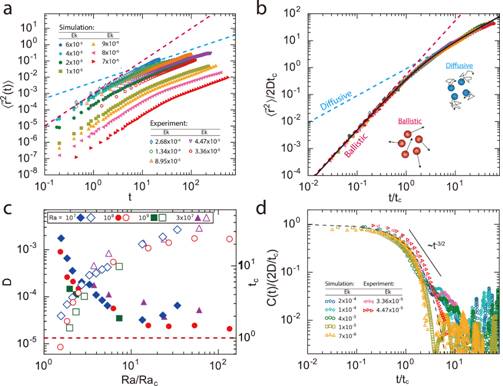Aresearch team from Tongji University led by ZHONG Jinqiang at the School of Physics Science and Engineeringpublishedimportant jointresearch findings of Brownian motion of vortices in turbulent systems last week. It is the work that was accomplished through the team’s collaboration with aresearch group led by Professor XIA Keqingwith Southern University of Science and Technology (SUSTech)and Chinese University of Hong Kong (CUHK).The research article Vortices as Brownian Particles in Turbulent Flows was published online in the prestigious journalScienceAdvanceson August 20, 2020.
Small grains suspended in a fluid exhibit irregular motion. As noted in this study, this phenomenon was first observed in 1827by British botanist RobertBrown, which came soon after the invention of the microscope. It was not until 1905 that Albert Einstein started togain adeep understanding about Brownian motion and,from a modern statistical physics perspective, Einstein made predictionsabout the statistical properties of the random motion of Brownian particles. In 1908, Paul Langevin developed the first equation of motion for Brownianparticles, known most commonly as the Langevin Equation. Langevin’s theory posits that, as the time scale increases, the motion of Brownianparticlesundergoes adirect transition from the ballistic regime to the diffusive regime. However, past experimental studies leading up to this oneshowed a smooth transition between the two dynamical regimes. This smooth transition is caused by the so-called hydrodynamic memory effect thatarises as the surrounding liquid displaced by moving particles reacts back tothe particles, and thereby generating long-range correlations. The pureBrownian motion, predictedlast centuryin the Langevin Equation, has not been observed directly in liquid systems.
In the currentstudy the researchersdemonstrate, through high-precision experiment and numerical simulation, the horizontal movement of the vortices (Fig. 1) in a rotating turbulent convective flow resembling that of inertial Brownian particles (e.g., initially,they move ballistically and then diffusively after a characteristic time of transition). Moreover, the researchers found the transition from ballistic to diffusive behaviors is direct, as predicted by Langevin, without first going through the hydrodynamic memory regime (Fig. 2). The results of this study elucidate the underlying physical mechanics for this observed directional transition--thehorizontal motion of the convective vortices is governed by the driving force from the surrounding turbulent flows and,being this force is highly random is best described as white noise. The researchers found it is for this reasonthe hydrodynamic memory effect is absent and the vortex motion exhibits strictly pure Brownian motion.
The authors noted further that turbulence is believed to be one of the most difficult problems to control for in classical physics. This work has shown that long-range correlated vortex structures arise in rotating turbulence. The movement and evolution of these large-scale turbulent structures are shown to follow well-known statisticalrulesin physics. As such, the double-blind peer reviewersofScienceAdvances made specific commentsin responseto these new research findings:
Since about 20 years ago, our understanding of such systems has been growing steadily with the present work providing an original and specific interpretation on top of what is already known of such systems.With regard to these two aspects, the authors come up with very interesting, original, and convincing results putting the vortex dynamics in rotating turbulent convection into a new framework.
The research group from SUSTech and CUHK, Dr. CHONG(first author of the article), DING, and XIA (corresponding author), performeda large-scale direct numerical simulation in this project. The Tongji research team of Dr. SHI (second author), DING, LU, and ZHONG (corresponding author) conducted high-accuracy experimental measurements.Led by Prof. ZHONG, the Tongji team has established successfully an advancedexperimental platform for studying rotating turbulence. Ongoing research projects of heat transport and flow-field visualization are being performed on two highly-controlled rotary tables, with cutting-edge experimental precision and resolution in the field. In recent years, the team has published in original research works in influential journals, thatinclude:Science Advances, Journal of Fluid Mechanics,Physical Review Letters,and Physical Review Fluids. The research work is supported by the National Science Foundation of China under Grant Nos. 11572230 and 11772235 and a NSFC/RGC Joint Research GrantNo. 11561161004.

Fig. 1 Vortex Structures in Rotating Thermal Convection.

Fig. 2 Statistical Data for the Horizontal Motion of the Convective Vortices. The data reveal the vortex motion is well predicted byLangevin’stheory of pure Brownian motion.
Official link to the article: https://advances.sciencemag.org/content/6/34/eaaz1110